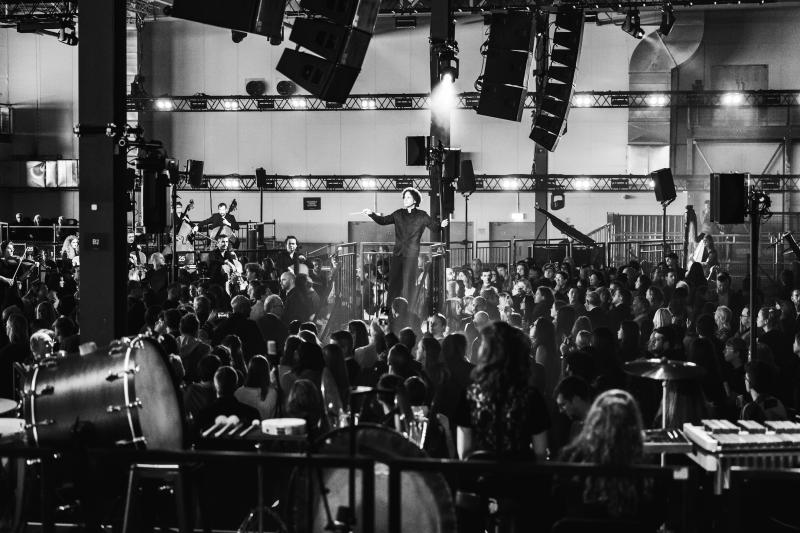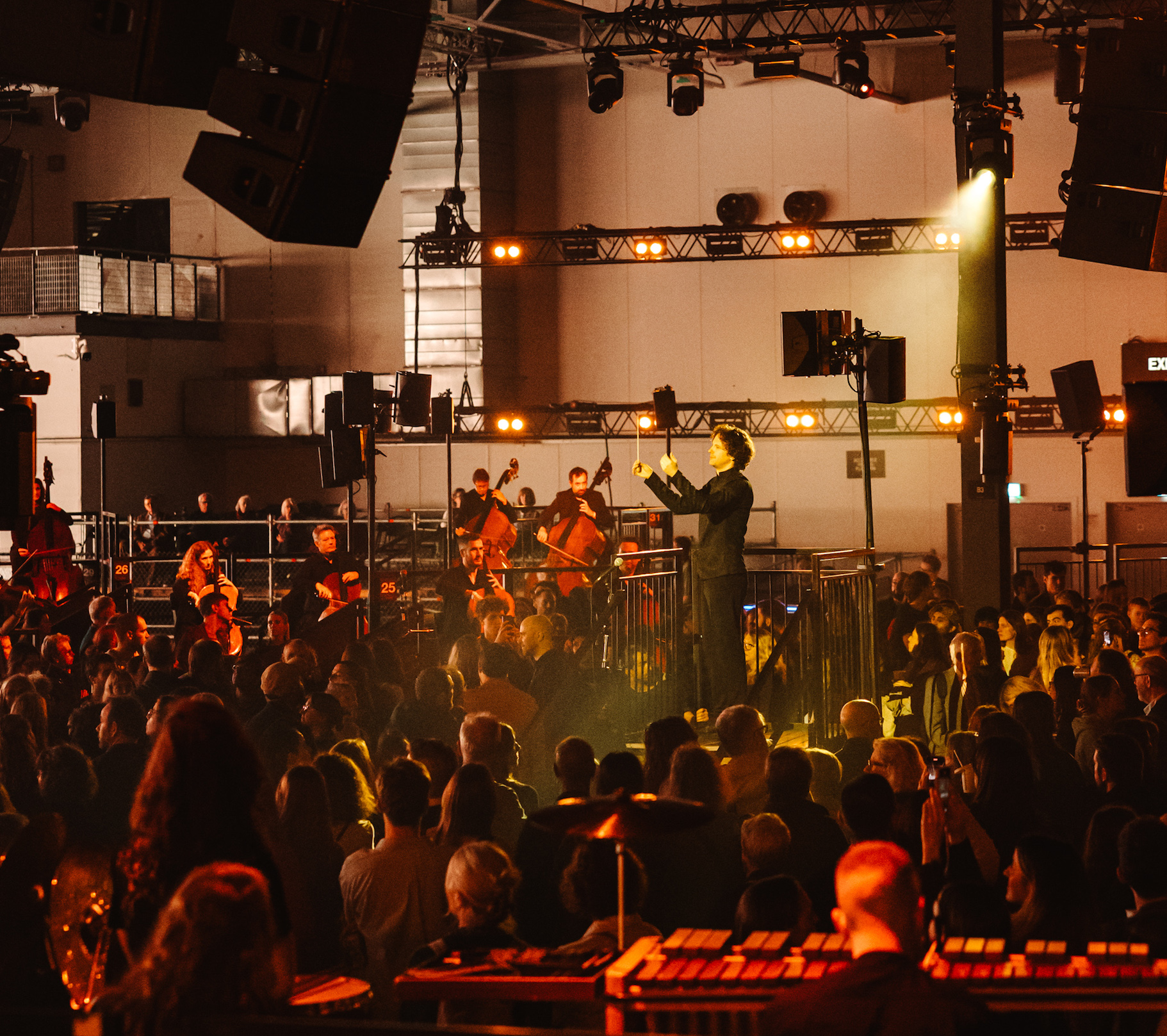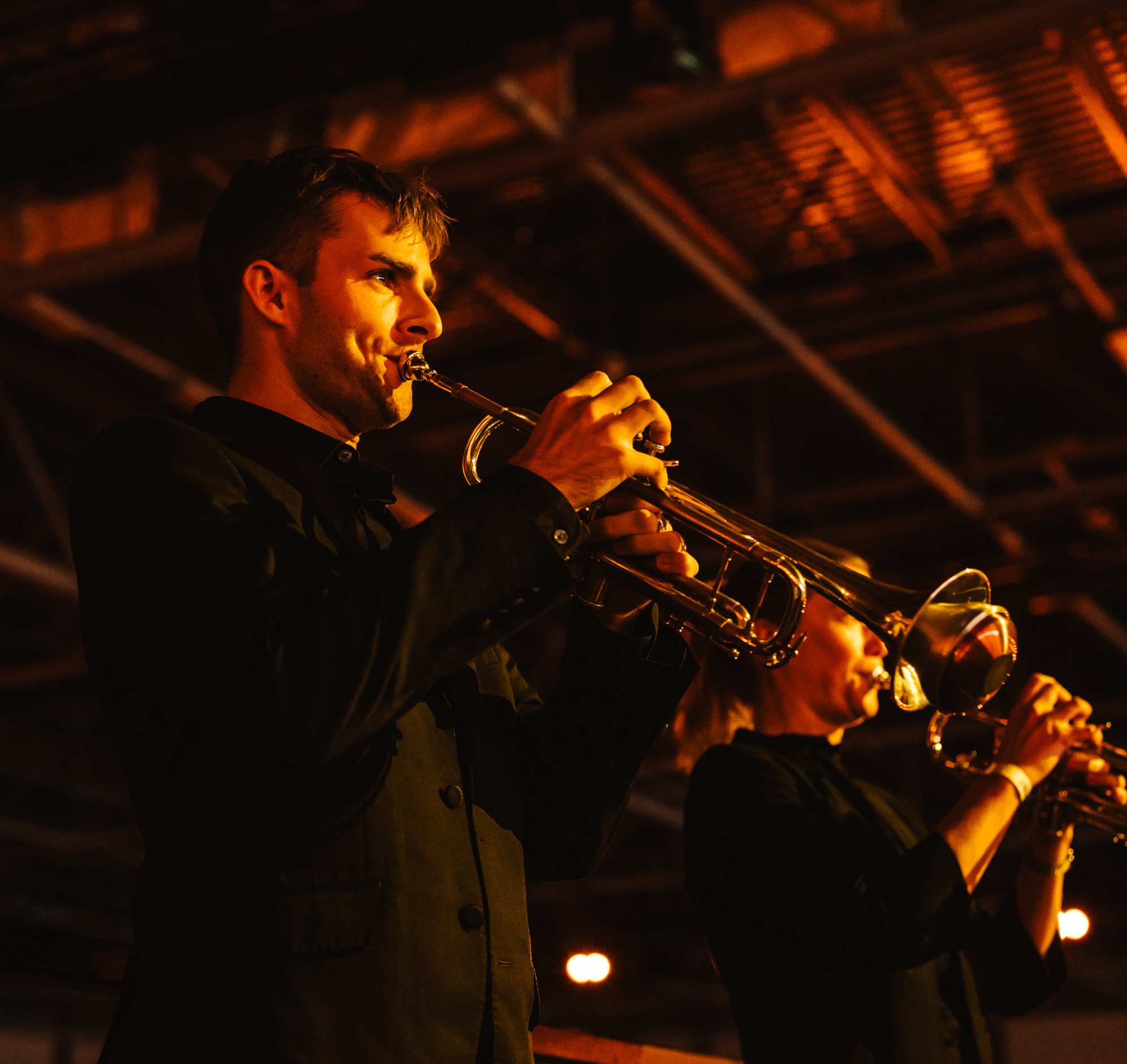Aurora Orchestra, Collon, Drumsheds review – surround-sound magic in the super-club | reviews, news & interviews
Aurora Orchestra, Collon, Drumsheds review – surround-sound magic in the super-club
Aurora Orchestra, Collon, Drumsheds review – surround-sound magic in the super-club
On a vast dancefloor, the chance to listen from inside the orchestra

Every lover of folk-tales knows that the seeker has to endure dangers and setbacks before they finally win the prize. Last night, the ever-enterprising Aurora Orchestra played The Firebird – Stravinsky’s own musical vision of the intrepid hero who outwits the forces of darkness – on a unique site that presents an audience with its own kind of ordeals. Once the Tottenham IKEA, Drumsheds has undergone a metamorphosis from super-store to super-club.
Set in a wilderness of concrete lots and wire fences, across a roaring highway, the big blue terminal-sized shed now offers 608,000 square feet of Berlin-style dance and performance space, with a 15,000 maximum capacity: Berghain comes to London N18. Grim chic it has to spare. In mega-club fashion, you queue between the wires for a body search at a forbidding control point that stands comparison with border crossings in conflict zones (and I’ve seen a few). Inside, the low-lit labyrinth of vast industrial spaces overawe and disorientate. All part of the joys of clubbing, of course. Drumsheds has comprehensively undomesticated IKEA into a sort of cavernous metal-heavy underworld. As an exercise in the techno-sublime, it’s tremendously effective. But as a classical venue?
 For an orchestral concert, the perilous quest fosters the hope – and the need – for some spectacular reward at journey’s end. By and large Nicholas Collon and the (as usual) scoreless and standing Aurora players delivered – both in the Firebird and their farewell flourish, Ravel’s Bolero. In the club’s enormous central room, Collon conducted from an elevated platform. Spread all around him, on separate raised “desks”, pairs of musicians fanned out in a circle two or (in the case of the strings) three layers deep. Each desk was individually miked but centrally (and discreetly) mixed: contrary to expectations, the volume never shot off the scale.
For an orchestral concert, the perilous quest fosters the hope – and the need – for some spectacular reward at journey’s end. By and large Nicholas Collon and the (as usual) scoreless and standing Aurora players delivered – both in the Firebird and their farewell flourish, Ravel’s Bolero. In the club’s enormous central room, Collon conducted from an elevated platform. Spread all around him, on separate raised “desks”, pairs of musicians fanned out in a circle two or (in the case of the strings) three layers deep. Each desk was individually miked but centrally (and discreetly) mixed: contrary to expectations, the volume never shot off the scale.
That in-the-round layout, making good use of Drumsheds’ huge interior plain, allowed audience members to promenade at will around the orchestra. A more crowded space would have impeded truly free movement; here, the numbers felt just right. In The Firebird, you could wander among the successive soloists as different instruments took up the themes of the mystic bird, hopeful prince, ensnared princess or wicked wizard-king. We listened, and watched, close-up from within the orchestra, not just on one spot but roving among as many as we chose.
Poised and unflappable, the Aurora players coped serenely with the milling herd all around them. And that extreme proximity only induced respect, even awe, for the skill on show at every turn. I especially enjoyed the flute duo of Jane Mitchell and Rebecca Larsen, along with Amy Harman’s unearthly bassoon and Fergus McCready’s plangent oboe – but each point on this sonic compass-rose had its shining moments.
The promenade setting meant that Collon, on his tower (pictured above), needed to keep a firm hand on the seething activity below. He led decisively and the players, for all the ambient distractions, crisply and tightly followed. In the spotlit gloom, with uncanny melodies bursting from one nearby or faraway thicket then another, the clubbing floor turned into an enchanted forest. And we were suitably bewitched. I had feared an elaborate gimmick, and the preliminary fuss of the entrance ritual soon lost its charm. But music, site and layout did combine to cast a spell.
 In fact, it was the smart deployment of these wide open spaces – rather than the epic post-industrial design – that really facilitated the special magic of listening from inside the orchestra. That surround-sound experience if anything intensified in Bolero. We could (literally) follow the tune around the orchestra from raised desk to raised desk after Henry Baldwin’s snare drum set off on the first – out of 169 – of its hypnotic grooves. Collon wittily introduced the performance. Indeed, the show’s immersive immediacy and informality would surely have made it a hit for schoolkids: a DIY young person’s guide to the orchestra, with no dull sitting-down required.
In fact, it was the smart deployment of these wide open spaces – rather than the epic post-industrial design – that really facilitated the special magic of listening from inside the orchestra. That surround-sound experience if anything intensified in Bolero. We could (literally) follow the tune around the orchestra from raised desk to raised desk after Henry Baldwin’s snare drum set off on the first – out of 169 – of its hypnotic grooves. Collon wittily introduced the performance. Indeed, the show’s immersive immediacy and informality would surely have made it a hit for schoolkids: a DIY young person’s guide to the orchestra, with no dull sitting-down required.
This time, I found myself enjoying the trumpet pair of Imogen Whitehead and Will Thomas (pictured above), but we couldn’t (quite) listen from every place at once; other standpoints would have yielded other pleasures. And, of course, there’s a particular aptness about rolling this piece, with its tapestry of mesmeric iterations, through a gigantic warehouse club more accustomed to trance or techno beats. Next time, some Steve Reich or Philip Glass maybe?
rating
Explore topics
Share this article
Subscribe to theartsdesk.com
Thank you for continuing to read our work on theartsdesk.com. For unlimited access to every article in its entirety, including our archive of more than 15,000 pieces, we're asking for £5 per month or £40 per year. We feel it's a very good deal, and hope you do too.
To take a subscription now simply click here.
And if you're looking for that extra gift for a friend or family member, why not treat them to a theartsdesk.com gift subscription?
more Classical music
 Aurora Orchestra, Collon, Drumsheds review – surround-sound magic in the super-club
On a vast dancefloor, the chance to listen from inside the orchestra
Aurora Orchestra, Collon, Drumsheds review – surround-sound magic in the super-club
On a vast dancefloor, the chance to listen from inside the orchestra
 Christian Gerhaher, Gerold Huber, Sheldonian Theatre, Oxford review - an unforgettable recital
The great German baritone in glorious voice at the Oxford International Song Festival
Christian Gerhaher, Gerold Huber, Sheldonian Theatre, Oxford review - an unforgettable recital
The great German baritone in glorious voice at the Oxford International Song Festival
 Kanneh-Mason, Sinfonia of London, Wilson, Barbican review - taking the roof off the Barbican
From musical also-rans to main event, culminating in a stunning Rachmaninov symphony
Kanneh-Mason, Sinfonia of London, Wilson, Barbican review - taking the roof off the Barbican
From musical also-rans to main event, culminating in a stunning Rachmaninov symphony
 Music from Pole to Pole, Clark, City of London Sinfonia, Smith Square Hall review - talk of clouds, music to match
Inspired evening journeying from the Antarctic to the Arctic through patterns in the air
Music from Pole to Pole, Clark, City of London Sinfonia, Smith Square Hall review - talk of clouds, music to match
Inspired evening journeying from the Antarctic to the Arctic through patterns in the air
 Kaleidoscope Chamber Collective, Hatfield House review - musical dreams in marble halls
Stylish, agile playing in the grandest of frames
Kaleidoscope Chamber Collective, Hatfield House review - musical dreams in marble halls
Stylish, agile playing in the grandest of frames
 Music Reissues Weekly: Arvo Pärt - Tabula Rasa
A foundational album returns
Music Reissues Weekly: Arvo Pärt - Tabula Rasa
A foundational album returns
 Classical CDs: Elephants, clocks and palindromes
A lovable French composer boxed up, plus discs of choral and chamber music
Classical CDs: Elephants, clocks and palindromes
A lovable French composer boxed up, plus discs of choral and chamber music
 Kanga, Manchester Collective, Singh, RNCM Manchester review - string ensemble playing at its most rewarding
New classics introduced and a world premiere with a dark story
Kanga, Manchester Collective, Singh, RNCM Manchester review - string ensemble playing at its most rewarding
New classics introduced and a world premiere with a dark story
 Hardenberger, BBC Philharmonic, Storgårds, Bridgewater Hall, Manchester review - splendour and a trumpeter's voluntary
Individuality and discipline in Strauss, Stravinsky, Haydn… and more
Hardenberger, BBC Philharmonic, Storgårds, Bridgewater Hall, Manchester review - splendour and a trumpeter's voluntary
Individuality and discipline in Strauss, Stravinsky, Haydn… and more
 First Person: conductor Robert Hollingworth on a four-choir rarity by Benevoli
I Fagiolini join with two other choirs for a spectacular in St Martin-in-the-Fields
First Person: conductor Robert Hollingworth on a four-choir rarity by Benevoli
I Fagiolini join with two other choirs for a spectacular in St Martin-in-the-Fields
 Elisabeth Leonskaja, Wigmore Hall review - a universe of sound and emotion in Schubert’s last three sonatas
Total mastery of epic adventures composed in the face of mortality
Elisabeth Leonskaja, Wigmore Hall review - a universe of sound and emotion in Schubert’s last three sonatas
Total mastery of epic adventures composed in the face of mortality

Add comment